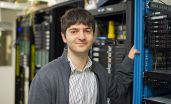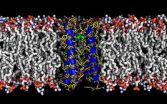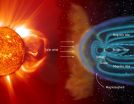(Press-News.org) HANOVER, N.H. - Human cells are protected by a largely impenetrable molecular membrane, but researchers have built the first artificial transporter protein that carries individual atoms across membranes, opening the possibility of engineering a new class of smart molecules with applications in fields as wide ranging as nanotechnology and medicine.
The study, which appears Friday, Dec. 19, in the journal Science, is a milestone in designing and understanding membrane proteins. A PDF is available upon request. The study was conducted by researchers from Dartmouth College, the University of California-San Francisco, Massachusetts Institute of Technology and National Institute of Science Educational and Research in India.
Each human cell is surrounded by a lipid membrane, a molecular barrier that serves to contain the cellular machinery and protect it from the surrounding elements. This cellular "skin" is impenetrable to most biological molecules but also presents a conundrum: if chemicals can't get in or out, how is a cell to receive nutrients (food) and remove unwanted products of metabolism (trash)? Nature has come up with an elegant solution to this logistical problem -- transporter proteins (or transporters). These molecular machines are embedded in the cellular membrane and serve as gatekeepers, allowing specific chemicals to shuttle in and out when needed. Though biologists have known about transporters for many decades, their precise mechanism of action has been elusive.
The researchers set out to "build" an artificial transporter protein from scratch, to learn how transporters work, and to open the possibility of engineering a new class of smart molecules. They developed new computational techniques to model the necessary molecular physics, enabling them to design a transporter protein through computer simulation. Specifically, computer simulations suggested which amino-acid building blocks should comprise the future transporter, so that it would carry ionic atoms of metal zinc in one direction across membranes, while pumping protons in the other. Using this computational blueprint, they created the molecule in the lab, referring to it as "Rocker" due to its predicted molecular dynamic properties: the protein was expected to "rock" between two alternating states, allowing it to drive atoms through.
"To our great excitement, experiments showed that Rocker did indeed transport zinc and protons and it did, in fact, rock between two states just as designed," says co-lead author Gevorg Grigoryan (http://dartmouth.edu/faculty-directory/gevorg-grigoryan), an assistant professor of computer science at Dartmouth. "Further, Rocker showed great selectivity, not transporting ions of calcium, another design feature."
Proteins are nature's workhorse molecules, performing a great variety of tasks in the cell from catalysis and sensing to generation of mechanical work. Learning to design (from first principles) novel protein molecules to perform specific tasks would mean that the immense richness of function that proteins have to offer can be brought to bear in a variety of applications, from better therapeutics to smart materials and clean energy solutions.
"Our findings are an important step forward in this pursuit, demonstrating that through the use of computer simulations to orchestrate precise properties of atomic structure and molecular dynamics, proteins can now be designed to carry out complex functions that rival those of natural molecular machines," Grigoryan says. "Further, our work represents a milestone in designing and understanding membrane proteins, a particularly challenging class of proteins."
INFORMATION:
Dartmouth Assistant Professor Gevorg Grigoryan is available to comment at gevorg.grigoryan@dartmouth.edu
Broadcast studios: Dartmouth has TV and radio studios available for interviews. For more information, visit: http://www.dartmouth.edu/~opa/radio-tv-studios/
A study of the way malaria parasites behave when they live in human red blood cells has revealed that they can rapidly change the proteins on the surface of their host cells during the course of a single infection in order to hide from the immune system.
The findings, which overturn previous thinking about the Plasmodium falciparum parasite's lifecycle, could explain why so many attempts to create an effective vaccine have failed and how the parasites are able to survive in the human body for such long periods of time.
In the study, Plasmodium falciparum parasites were ...
Scientists and engineers have built a computer model that has uncovered disease-causing mutations in large regions of the genome that previously could not be explored. Their method seeks out mutations that cause changes in 'gene splicing,' and has revealed unexpected genetic determinants of autism, colon cancer and spinal muscular atrophy.
CIFAR Senior Fellow Brendan Frey (University of Toronto) is the lead author on a paper describing this work, which appears in the Dec. 18 edition of Science Express. The paper was co-authored by CIFAR senior fellows Timothy Hughes (University ...
The evolution of trichromatic color vision in humans occurred by first switching from the ability to detect UV light to blue light (between 80-30 MYA) and then by adding green-sensitivity (between 45-30 MYA) to the preexisting red-sensitivity in the vertebrate ancestor. The detailed molecular and functional changes of the human color vision have been revealed by Shozo Yokoyama et al. Emory University and is published in the journal PLOS Genetics.
The molecular basis of functional differentiation is a fundamental question in biology. To fully appreciate how these changes ...
CAMBRIDGE, MA -- For decades, neuroscientists have been trying to design computer networks that can mimic visual skills such as recognizing objects, which the human brain does very accurately and quickly.
Until now, no computer model has been able to match the primate brain at visual object recognition during a brief glance. However, a new study from MIT neuroscientists has found that one of the latest generation of these so-called "deep neural networks" matches the primate brain.
Because these networks are based on neuroscientists' current understanding of how the ...
A University of Southampton researcher has helped solve a long standing space mystery - the origin of the 'theta aurora'.
Auroras are the most visible manifestation of the Sun's effect on Earth. They are seen as colourful displays in the night sky, known as the Northern or Southern Lights. They are caused by the solar wind, a stream of plasma - electrically charged atomic particles - carrying its own magnetic field, interacting with the earth's magnetic field.
Normally, the main region for this impressive display is the 'auroral oval', which lies at around 65-70 degrees ...
PROVIDENCE, R.I. - Where you live affects the type of bacteria that cause bloodstream infections, according to researchers at Rhode Island Hospital and an international team of investigators. The closer you live to the equator, the greater the likelihood of a bloodstream infection caused by a group of bacteria called Gram-negative bacteria, which thrive in warm and moist environments, compared to another group of bacteria referred to as Gram-positive bacteria. The study also found that the proportion of a country's GDP spent on health care impacted the type of bacteria ...
DALLAS - Dec. 18, 2014 - Retroviruses are best known for causing contagious scourges such as AIDS, or more sporadically, cancer.
But researchers at UT Southwestern Medical Center and Karolinska Institutet in Stockholm, Sweden, found that endogenous retroviruses (ERV) also play a critical role in the body's immune defense against common bacterial and viral pathogens.
"Most scientists have become used to the view that retroviruses are generally harmful," said Nobel Laureate Dr. Bruce Beutler, Professor and Director of UT Southwestern's Center for the Genetics of Host ...
Primates visually recognise and determine the category of an object even at a brief glance, and to date, this behaviour has been unmatched by artificial systems. A study publishing this week in PLOS Computational Biology has found that the latest artificial "deep neural network" performs as well as the primate brain at object recognition.
Charles Cadieu and colleagues from MIT measured the brain's object recognition ability by implanting arrays of electrodes in the inferior temporal cortex of macaques. This allowed the researchers to see the neural representation -- the ...
A definitive geological timeline shows that a series of massive volcanic explosions 66 million years ago spewed enormous amounts of climate-altering gases into the atmosphere immediately before and during the extinction event that claimed Earth's non-avian dinosaurs, according to new research from Princeton University.
A primeval volcanic range in western India known as the Deccan Traps, which were once three times larger than France, began its main phase of eruptions roughly 250,000 years before the Cretaceous-Paleogene, or K-Pg, extinction event, the researchers report ...
(Boston)--Dr. Deborah Anderson from Boston University School of Medicine (BUSM) and her colleagues are challenging dogma about the transmission of the human immunodeficiency virus type 1 (HIV-1). Most research has focused on infection by free viral particles, while this group proposes that HIV is also transmitted by infected cells. While inside cells, HIV is protected from antibodies and other antiviral factors, and cell-to-cell virus transmission occurs very efficiently through intercellular synapses. The Journal of Infectious Diseases (JID) has devoted their December ...



